 Charles Herrick’s Guest Post series from June 2020 explores the system put in place by the Supreme Headquarters Allied Expeditionary Forces (SHAEF) for gathering, retrieving, and transporting front-line reportage from the Normandy coast back to England on and immediately after D-Day. Last year, as I read and edited it, a question occurred (or reoccurred) to me.
Charles Herrick’s Guest Post series from June 2020 explores the system put in place by the Supreme Headquarters Allied Expeditionary Forces (SHAEF) for gathering, retrieving, and transporting front-line reportage from the Normandy coast back to England on and immediately after D-Day. Last year, as I read and edited it, a question occurred (or reoccurred) to me.
From any rational standpoint, the plan devised by SHAEF as outlined by Herrick immediately seems not just woefully inadequate but doomed to failure from its very inception. Given Herrick’s description of the Army as an entity, the fact that SHAEF constituted a joint venture involving different forces from different countries, and the sheer scope of this invasion, I would think that anyone within the military would look at this notion (“Yeah, we’ll send one guy in to handle the coverage from all photojournalists and cinematographers on both U.S. beaches”) and find it laughable.
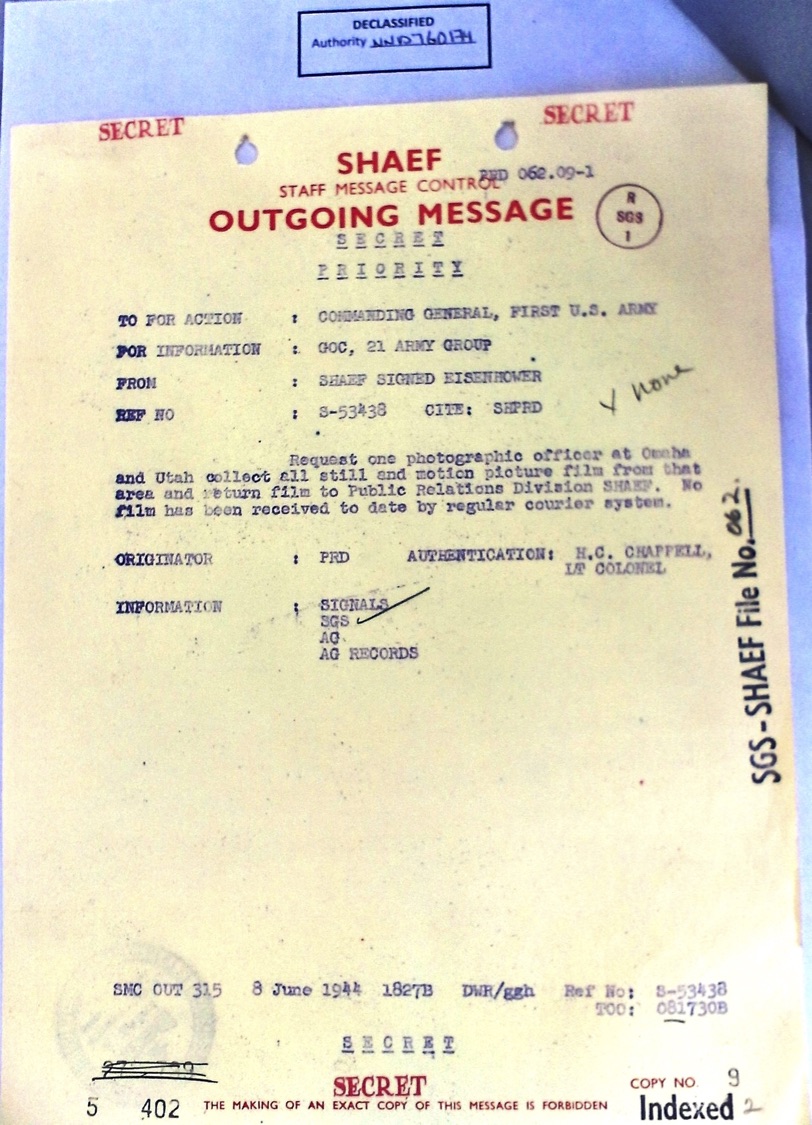
Figure 16. A June 8, 1944 SHAEF message from Commander in Cheif Dwight Eisenhower to Gen. Omar Bradley requesting delegation of an officer to collect film from Omaha and Utah beaches.
•
I also have to believe that anyone from the civilian side who had either direct experience reporting from the front or even the experience of dealing with getting material through the Ministry of Information censorship system in London — from journalists and photojournalists on up to their editors and picture editors — would find this prima facie insufficient. To call it a bottleneck grossly understates the inevitable constraint it exercised over all outgoing civilian correspondents’ reportage of the invasion during its first days.
So I assume that while vague promises got made to the accredited correspondents and their editors, details of the actual plan (if we can dignify it with that term) got withheld on the grounds of military secrecy. Thus no one from the civilian side had any idea of what SHAEF in fact intended in this regard, and certainly no input into it.
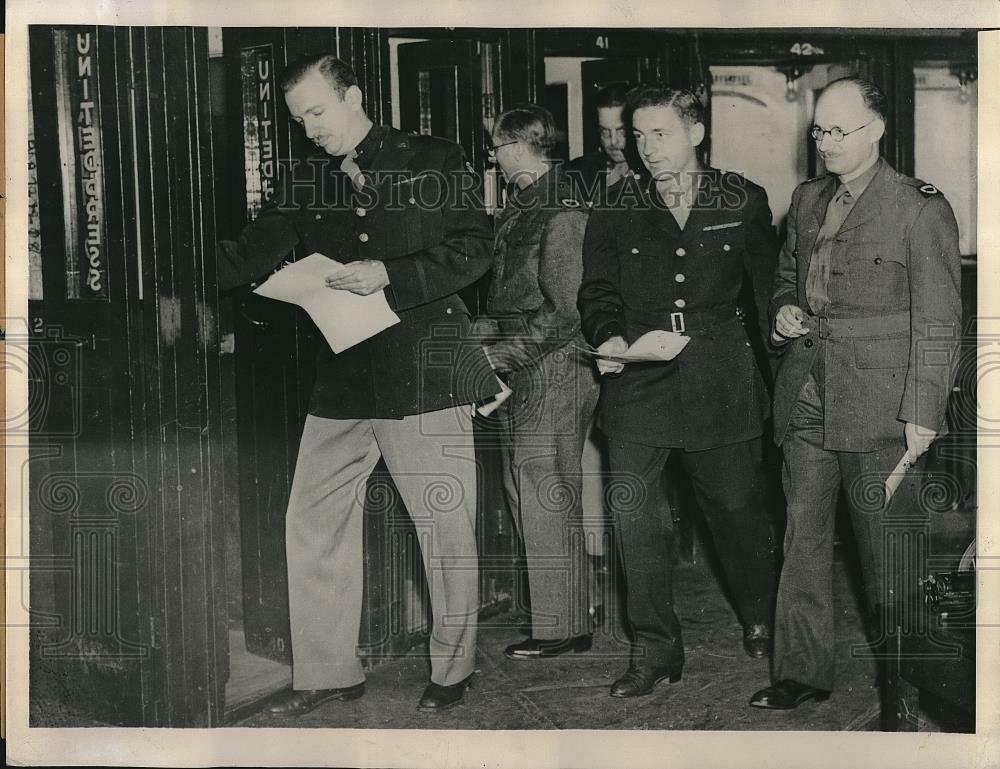
Walter Cronkite (left) and other reporters at SHAEF headquarters on D-Day. Acme Pictures, photographer unknown.
•
Which leads me to my question: Was all that deliberate? Not just the secrecy (understandable) but the utter inadequacy of the plan? It seems intentionally designed to prevent material generated by the civilian press corps from even reaching the Ministry of Information, much less the periodicals and press pool, for the first days of the invasion. That would leave the press largely dependent on reportage generated by the Signal Corps, the U.S. Coast Guard, and other military correspondents, which SHAEF itself would vet in-house and whose withholding and/or release SHAEF would control, with those decisions unchallenged.
At the time, unbeknownst to the public, to the press, and indeed to all but a handful of highly placed figures within its upper echelons, SHAEF had well underway a top-secret disinformation campaign. Dubbed Operation Fortitude South, this project aimed at encouraging the German high command to think that the Normandy invasion was a ruse, intended to distract them from the real invasion, which Hitler and his generals already believed would come at Pas de Calais.
•
With Operation Fortitude South in mind, should we consider the possibility that SHAEF’s system-within-a-system for retrieval of civilian press coverage of the invasion did not in fact fail, but instead operated exactly as it was intended to do? Sure, the publications and press pool would (and did) get up in arms and throw fits about the slow and minimal dribble of coverage from the beachhead during the first days of the invasion. But that would (and did) blow over as the flow of material gradually improved.
Meanwhile, the trickle of material released during the first few days of the invasion convinced the Nazis in Berlin that their assumption of a feint was correct and required no massive allocation of troops and equipment. By the time they realized their error the Allies had secured the Normandy beachhead and pushed well inland. At which point coverage of the front normalized.
Coincidence? You decide. With this question on the table, I encourage you to read (or re-read) Herrick’s four-part series, because it also serves as prelude to an upcoming sequel now in production here.
Getting the Word Out
Update on recent publications of my articles based on this research project:
• According to Scott Hilton, a member of the SPE Board of Directors’ Communications Committee, as of August 11, 2019,
“[Your Robert Capa article] currently has 45K views, 25K through referrals from Facebook. … [It] has by far the largest reader count of Exposure on Medium. Quite probably, it’s the most widely read article in the 50-year history of Exposure.” (As of March 29, 2021, Hilton emailed me, “… the view count on your Robert Capa article … is currently at 56K. There was a big spike of 2.7K views on 6/6/20.”)
• According to Michael Zhang, editor of Petapixel.com, as of July 9, 2019, the appearance of the same article there has had even better results:
“It looks like that article has gotten 65,781 views total. … Pretty good. Definitely above average, but not a MAJOR hit in terms of pageviews. It received about 3,000 shares on Facebook. We’ve had some stories exceed 100,000 shares.”
Queried on March 29, 2021, Zhang provided this update: 93,416 views.
 So, to date, those two online publications of my March 2, 2018 presentation at the Society for Photographic Education 55th Annual Conference in Philadelphia, PA have put a synopsis of this research before close to 150,000 readers, most of them people with a serious involvement in photography.
So, to date, those two online publications of my March 2, 2018 presentation at the Society for Photographic Education 55th Annual Conference in Philadelphia, PA have put a synopsis of this research before close to 150,000 readers, most of them people with a serious involvement in photography.
I have added to each of these web features an author’s note pointing readers to the results of our most recent research, which do not change the main thrust of what we have determined, but provide answers to some open questions and explanations for some otherwise mysterious aspects of the tale, including Capa’s decision to leave Omaha Beach so quickly after arriving there on June 6 and the probable fate of the first 28 images on the one roll of 35mm film he exposed that morning. You’ll find those here and here.
Bucking the Tide
Unfortunately, other sources continue to get it wrong, heedlessly parroting the received but now disproved version of the Capa D-Day story. Those responsible for perpetuating the myth range widely in visibility and influence, and now include:
• The Getty Museum, in its text accompanying “The Face in the Surf”: “… Although Capa shot 72 images that day, all but eleven were ruined when the negatives were placed in an overheated film drying cabinet in a London lab. The images that survived appear grainy and blurry, partly due to this error, and partly due to Capa’s nerves. …”
• The Harry Ransom Center, University of Texas, Austin, in its text accompanying “The Face in the Surf”: “… When his rolls of film arrived for development at the Life magazine office in London, a darkroom assistant was told to rush the processing to get the photographs to New York for publication in the next issue. The assistant placed the newly developed film in a drying cabinet on high heat, melting the emulsion on three of the four rolls. Luckily, ten images from the fourth roll were not entirely destroyed …” (Credited to Dr. Jessica S. McDonald, the Nancy Inman and Marlene Nathan Meyerson Curator of Photography.)
 • The BBC, in “The world-famous couple that changed photography forever,” published on February 15, 2021: In this short video interview with Marc Aronson and Marina Budhos, co-authors of the 2017 book Eyes of the World: Robert Capa, Gerda Taro, and the Invention of Modern Photojournalism, Aronson repeats the now-disproved myth that Capa landed with the first wave on D-Day. The piece also highlights Capa’s Spanish Civil War image “The Falling Soldier” without even mentioning the controversy over it or the extensive scholarship showing that it was staged. The titular claim that Capa and Taro “changed photography forever” I find risible, and I can’t imagine why the producers decided to put out this vacuous puff piece on a book four years old. (Credits: Video by Maria Badia / Executive Producer: Alba Jaramillo / Producer: Mia Hariz / Commissioning Editor: Anna Bressanin.)
• The BBC, in “The world-famous couple that changed photography forever,” published on February 15, 2021: In this short video interview with Marc Aronson and Marina Budhos, co-authors of the 2017 book Eyes of the World: Robert Capa, Gerda Taro, and the Invention of Modern Photojournalism, Aronson repeats the now-disproved myth that Capa landed with the first wave on D-Day. The piece also highlights Capa’s Spanish Civil War image “The Falling Soldier” without even mentioning the controversy over it or the extensive scholarship showing that it was staged. The titular claim that Capa and Taro “changed photography forever” I find risible, and I can’t imagine why the producers decided to put out this vacuous puff piece on a book four years old. (Credits: Video by Maria Badia / Executive Producer: Alba Jaramillo / Producer: Mia Hariz / Commissioning Editor: Anna Bressanin.)
• Tom Demerly, at his eponymous blog, in this 2018 post, “Icons of the Invasion: The Robert Capa D-Day Photos”: “… Had Capa’s photos turned out to be well composed, in focus and correctly exposed with the negatives arriving to the darkroom undamaged our perception of D-Day and, in fact, warfare overall, would be different today. … In point of fact, Robert Capa’s D-Day photos changed the world to a similar degree the invasion itself did. … Although Capa shot a total of 106 frames before, during and after the landing of the second invasion wave he accompanied, most were destroyed by a fifteen-year-old lab assistant named Dennis Banks working for Life magazine in London. Banks accidentally set a film negative dryer too high and melted three complete rolls of film. In a bizarre allegory, it is as though those lost images symbolize the soldiers lost on Omaha Beach that day. Even Capa’s ruined images remain significant. … Only 11 total photos by Robert Capa of the D-Day invasion survived the darkroom error. Capa never mentioned the loss of the images. He took the matter completely in stride, the horrors and loss of battle having hardened him. …” I suppose we shouldn’t expect anything less feverish from the author of a blog subtitled “Insights on the Endurance, Technical and Adventure Lifestyle.” The problem remains, however, that overwrought blather like this get read by people who take it seriously, incorporate it uncritically into their thinking, and pass it on.
Two Newly-found Primary Sources
Some online sleuthing by Rob McElroy turned up two relevant period articles previously unknown to us, both by direct participants in the photographic coverage of D-Day: Bert Brandt, the British photographer whose pictures of the landing became the first distributed images of the invasion, and E. K. Butler, who headed the press pool.
Brandt’s first-hand account of his own D-Day experiences appeared in — of all places — Popular Mechanics, still publishing and nowadays both in print and online. (To download a PDF of the article, click here.) It may also have appeared in a U.K. publication. If we take it at face value (and I see no reason not to), Brandt’s account indicates that he did get ashore on Omaha Beach and made a number of images there that, he and Butler suggest (see below), fell to the censor’s scissors for reasons unspecified.
This would contradict John Morris’s snide comment in his memoir about Brandt, to the effect that he didn’t even get his feet wet during the landing. True, the only images of Brandt’s that we have from the landing are distance shots made from his incoming landing craft, but apparently those weren’t the only ones he made. I particularly enjoyed the detail of him using a repurposed inner tube as “a combination camera case and life preserver.”
Also worth noting that, unlike Capa, Brandt actually shlepped his Speed Graphic and plateholders with him; he estimates the combined weight of his photo gear at 72 pounds. Extremely old-school. Not exactly wrangling a 16×20 plus glass plates on muleback up Mt. Rainier, but impressive for a beachhead landing. (By contrast, Capa traveled light: 2 Contax II 35mm. cameras, one Rolleiflex, and a two-day supply of roll film.)
Butler’s piece, titled “Invasion Pictures Took Long Preparation: Still Photo Pool Organized Months Ahead, Rehearsals and Tests Carried Out,” appeared in the November 18, 1944 issue of Editor & Publisher — then a weekly, later a monthly, and also still publishing. (To download a PDF of the article, click here.) Butler’s comment about deleting details from Brandt’s negatives with a razor knife to satisfy the censor shows how closely the press pool worked with the censors at the Ministry. Not at all adversarial, though he does indicate that some fast talking helped to get some pix through unscathed.
They don’t really add much to what we know, mostly local color/first-person detail. I would assume there are other accounts by other photographers who took part in the invasion. I would also expect them to prove relatively generic, like Brandt’s. What’s most useful about Butler’s is that it gives us a brief glimpse of how things got organized on the receiving/incoming end at the press pool and the Ministry of Information, and what went on there. Tantalizing, but also frustrating. I want much more.
Not incidentally, the publications in which these articles appeared — Editor & Publisher a small-circulation publishing-industry weekly, Popular Mechanics a newsstand monthly aimed at amateur mechanics, carpenters, etc. — indicate the marginality of any interest in the specifics of D-Day coverage in the months immediately after the invasion. Safe to say that no one with a serious or even passing interest in journalism, photography and/or photojournalism/press photography would have likely come across either article.
•
Speaking of which, Rob McElroy also discovered this Capa D-Day image at the ICP website:
![Robert Capa [American soldiers landing on Omaha Beach, D-Day, Normandy, France], ICP website, screenshot](https://www.nearbycafe.com/artandphoto/photocritic/wp-content/uploads/2021/03/Robert_Capa_American_soldiers_landing_on_Omaha_Beach_D-Day_ICP_screenshot_3-29-21.jpg)
Robert Capa [American soldiers landing on Omaha Beach, D-Day, Normandy, France], ICP website, screenshot
•
Clearly made with Capa’s Rolleiflex, and showing the hedgehogs and shoreline, it was made just as LCI(L)-94 pulled away from the Easy Red sector, with Capa looking back at the beachhead. It comes earlier in that sequence than several frequently published Rolleiflex images of that vista made from further out at sea. Here you can still make out the form of the assault vehicle behind which he sheltered, on the left side of the image. (Click here to view it larger at the ICP website.)
The ICP web page for this image indicates that it’s a gelatin-silver print. As a Capa D-Day image, it’s new to me. I don’t recall seeing a negative thereof contact-printed in the Capa binders I perused during my visits to the ICP’s Capa archives in 2014, it wasn’t shown to me with the ICP’s other holdings of prints of his D-Day pictures, and I’ve never seen it reproduced. Yet the accompanying information indicates that it’s a 2007 acquisition. Strange.
I don’t think it changes the narrative in any way. It simply indicates that Capa had recovered sufficiently from his time in the surf to start photographing as LCI(L)-94 pulled away.
•
This post sponsored in part by a donation from David Freund.
•
 Special offer: If you want me to either continue pursuing a particular subject or give you a break and (for one post) write on a topic — my choice — other than the current main story, make a donation of $50 via the PayPal widget below, indicating your preference in a note accompanying your donation. I’ll credit you as that new post’s sponsor, and link to a website of your choosing.
Special offer: If you want me to either continue pursuing a particular subject or give you a break and (for one post) write on a topic — my choice — other than the current main story, make a donation of $50 via the PayPal widget below, indicating your preference in a note accompanying your donation. I’ll credit you as that new post’s sponsor, and link to a website of your choosing.
And, as a bonus, I’ll send you a signed copy of my new book, poetic license / poetic justice — published under my full name, Allan Douglass Coleman, which I use for my creative writing.


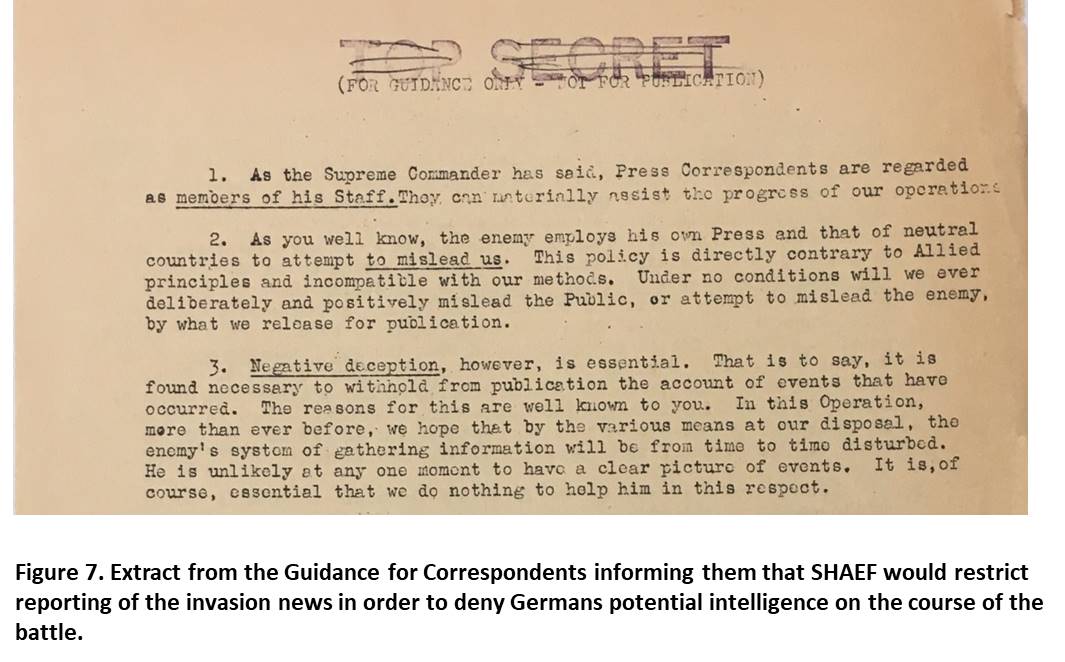
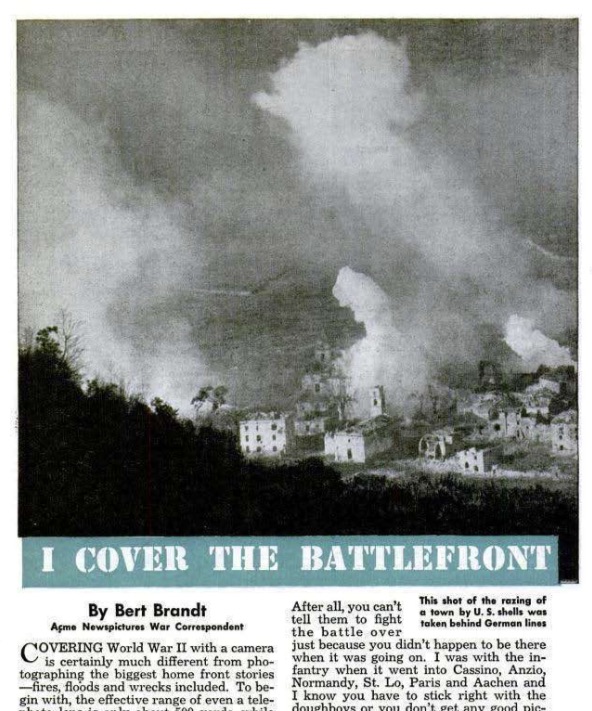
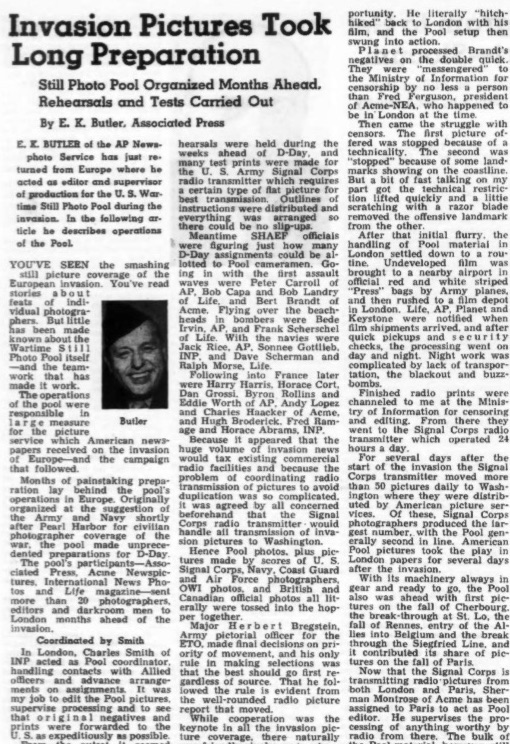




Is this last previously unknown Capa D-Day shot the 11th negative that is/was missing from the group that was processed in London? Just wondering.
In one sense, the missing 11th negative exists only because John Morris claimed to have salvaged 11 negatives from the mythical darkroom disaster. From that came the legend of “The Magnificent Eleven,” whereas in actual fact we only have evidence of ten exposures in Capa’s Easy Red sequence — either the actual negatives or else contemporaneous ink reproductions of two that have since gone astray (including “The Face in the Surf”).
Those ten unquestionably end the roll of 35mm Super-XX film, so if there were an eleventh in that sequence it would have had to precede them — in which case it would have shown something in the Higgins boat prior to the troops disembarking from it.
There were of course preceding frames on that roll — 26 or so. According to my current hypothesis, based on Charles Herrick’s research, these got excised by the censors at the Ministry of Information in London on the afternoon/evening of June 7, before they sent on to Morris whatever they deemed publishable — the magnificent ten, let’s call them.
Made, presumably, during the morning trip from the USS Samuel Chase to Omaha Beach, most likely the deleted frames showed the scale of the invading flotilla — or at least the portion of it surrounding the vessel on which Capa made his way in. With the deception of Operation Fortitude South in play, the Allies did not want Nazi headquarters in Berlin to understand the size of the Normandy venture. Not knowing this, Capa would have made such exposures as establishing shots, as a matter of course.
Per my commentary, Capa made this exposure as he left the beach, by which time he had switched to his 2-1/4″ Rolleiflex.
This is a 2-1/4 negative so not the missing 35mm frame.